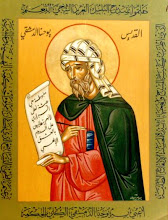The Exapostilarion and Praises
A short litany and versicle leads to the Exapostilarion. The Exapostilarion is a hymn related to the Eothinon Gospel reading. Its name derives from the command of our Lord in sending out the apostles to proclaim the Gospel. Exapostilaria are always chanted in the tone associated with the corresponding Eothina. As Eothina nine, ten and eleven are associated with tones five, six and eight, respectively, the Exapostilarion adds musical richness to the service. The subject matter of Exapostilaria typically encourages greater attention to praise of the Most Holy Trinity, particularly in the next section of Orthros called “The Praises”.
The Praises are verses from psalms 148, 149 and 150. Hymns from the Octoechos or other liturgical books are interspersed. As the Kathismata and Evlogitaria combine to reveal the magnificent blessing of the Resurrection, the Canon (or Katavasia) and Praises likewise combine to both instruct and offer adoration to the Holy Trinity. The praises, particularly, exemplify a sense of the timelessness of True Worship of God.
The praises are concluded with the Doxastikon (the “hymn of glory”, so called as it follows “Glory to the Father…”), typically related to the Eothinon of the day and thus chanted in the appropriate tone, but always concluding with a Troparion to the Virgin (Theotokion) that is chanted in tone two.
In modern practice, Orthros ends with the chanting of the Great Doxology and one of two short hymns or the Troparion of a particular Feast. In most parishes, the Doxology is commonly chanted in the same tone every week (Tone Three is a favorite), although it is appointed to chant the Doxology in the tone of the Eothinon. In the Great Doxology, the Church unites her praise to that of the Angelic Powers. Unlike the Doxology in the West, the Byzantine Great Doxology continues with various psalm verses leading to a triumphant chanting of “Holy God, Holy Mighty One, Holy Immortal One, have mercy on us.” The movement from initial praise of the Holy Trinity that began with the Trisagion Prayers has progressed through various stages of adoration to a hymn of exaltation. The repentant flock stands joyfully ready to offer the Lord the summit of its worship in the Divine Liturgy, which begins immediately after the final hymn of Orthros.
As a concluding note, the Sunday/Festal Orthros actually continues beyond the Great Doxology with additional litanies and prayers. These are often quietly offered by the priest and deacon during the chanting of the Doxology. In this way, the integrity of the service, and its similarity of structure to the other forms of the service (such as the weekday forms) is preserved.
Conclusion
Orthros is the most complex and variable service in the Byzantine Tradition. Attentive participation rewards the worshipper in enhanced understanding of Church teachings and deeper spiritual growth in the Image and Likeness of God. Attendance at Orthros is a most worthy part of one’s preparation for the Divine Liturgy.
Subscribe to:
Post Comments (Atom)


No comments:
Post a Comment